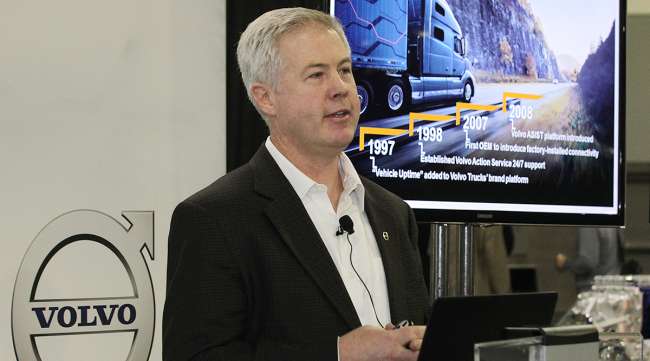Managing Editor, Features and Multimedia
Volvo Rolls Out Remote Programming for Over-the-Air Vehicle Software Updates

ATLANTA — Volvo Trucks said it has begun rolling out its Remote Programming feature for over-the-air vehicle software updates to help customers streamline maintenance and prevent vehicle downtime.
The truck maker touted Remote Programming as the latest major advancement in the use of connected-vehicle technology to boost “uptime” for fleets.
“Uptime is more than just technology. This is really combining technology, people and processes that are working with our trucks every day to keep them up,” said Conal Deedy, Volvo Trucks’ director of connectivity services.
Remote Programming enables Volvo customers to perform over-the-air software and parameter updates anywhere with a cellular connection in the United States and Canada.
That capability makes it easier for fleets to ensure that their vehicles are updated to “the latest and greatest software calibration,” Deedy said during a March 6 press conference here at the annual meeting of American Trucking Associations’ Technology & Maintenance Council.
Volvo said more than 1,300 trucks in North America have received software and parameter updates over the air since the company first introduced the feature in 2017 for model year 2018 Volvo models equipped with factory-installed connectivity hardware.
As a result, customers have saved more than 600 days in downtime, Deedy said.
The truck maker said its remote programming of software and parameter updates takes about 20 minutes on average, compared with the 2.3-day industry average when a truck arrives at a bay and receives manual updates.
To perform the updates, customers must park in a safe location, engage the parking brake and have the engine off with the key in the on position.
In addition to software updates, customers can also remotely change certain vehicle parameters such as road speed and change vehicle modes to minimize fuel usage, maximize truck performance or set a balanced approach.
Customers can perform two parameter updates per year for the first two years in service, or purchase a subscription for additional updates.
Jason Plumlee, director of maintenance at Saia Inc., said Remote Programming is providing the fleet with opportunities to improve maintenance scheduling by removing the need to plug in for an update.
The less-than-truckload carrier utilizes its tractors on tight schedules, such as running linehaul at night and conducting pickup-and-delivery operations in the day, which makes it tougher to find time for scheduled maintenance work.
“We have a short window that we have to work with,” Plumlee said. “It’s one of our largest challenges.”
He also cited the benefits of keeping up with the most current calibration updates to take advantage of improved fuel economy.
Saia, based in Johns Creek, Ga., ranks No. 28 on the Transport Topics Top 100 list of the largest for-hire carriers in North America.





